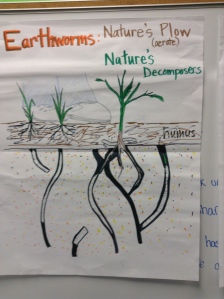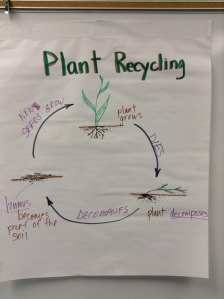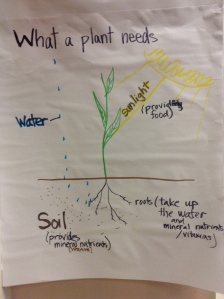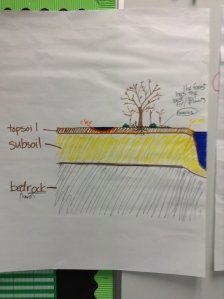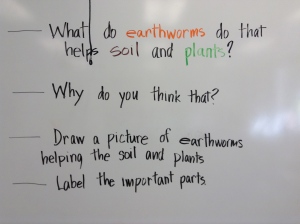
Image courtesy of Idea go / FreeDigitalPhotos.net
When I left my house this morning all excited for guiding the wrap-up of this week’s science investigations about soil, I was feeling pretty good. I went over the lesson plan first thing in the morning with my cooperating teacher, made a few slight changes and, then, was exited to pull the ideas together with the kids. But, I had to wait the whole day to do it. Science is the very last hour at the end of the day – not a bad time for science, since the kids excitement keeps them alive, but I was going to have to wait. Little did I know what the rest of the day had in store for me…
The morning went according to plan and I even got to tie science into Reader’s Workshop, leading a discussion about “the main idea” using one of the texts I pulled from our “soils library” to better enforce an idea from our soil investigations. I was sitting eating lunch with the 2nd grade team, going over our planning for the following week, when the music teacher came in. The teacher whose room we were in asked what the the music teacher needed from her and the music teacher said, “Actually I came to ask you (pointing to me) something.” I had no idea what was about to happen. It was a little surreal. There are some things I never pictured myself teaching and I was just about to be asked to teach the thing I never thought of in my wildest dreams… in 10 minutes.
The music teacher asked me if I could teach a different 2nd grade class (not the 2nd graders I know) music. Music! Not art or PE, but music! The music teacher’s young baby was really sick and she had to go home. I didn’t have time to think about the reality and accepted, but I did state that I really knew very little about music. Music was the one subject I really had no idea what to do with. She stated that she had a sub-plan and proceeded to show me a music card that dealt with quarter noters, quarter rests and double eighth notes. I had to ask if she could quickly demo what those terms meant. She had another music activity to fill up the other half of the 35 minute music period.
I quickly put my lunch away and dove into this new reality as a MUSIC TEACHER. …very bizarre. I was on my own with the class, they were teaching me the ideas and then we dove into the game. The game went well and together we found ways to enrich the game and take it further. We had a relatively quick and seamless transition back to the desks for the second activity when the announcement was made over the loudspeaker, “This is a Lockdown Drill.”
There are so many drills these days that I was not exactly sure what this one exactly required. And, did I mention, I had only witnessed one fire drill in September. I had never in all my life experienced a lockdown drill and this is not something my CT and I have discussed. The kids were great. They knew where to go and one little boy guided me with the details of what he thought I should do. “The shades need to go down. The lights off. ” That was all I got. After doing those steps I went to huddle with the kids behind the bookshelves. Then it occurred to me: How long do these things last? Does someone come around to check? When will I know it is okay to return back to class? How long can I keep 24 2nd graders quiet in such a crammed space?
As these thoughts were going through my head I noticed quiet crying. Someone said, “Ivan (pseudo name) is crying.” Ivan was a new kid to the school and did not understand what was happening. I told him this was a practice drill. Air expelled from his lips and the tension and tears fell away. The kids in the back started to get antsy. They were crammed in pretty tight and in uncomfortable positions. One student was actually in the bookshelf. They were starting to get louder. It was hard for me to say much to them as they were tucked furthest away from me. I managed to be stern enough to keep them relatively quiet. The principal came by and popped in reminding us that the door needed to be locked. (Later I found out the makeshift construction paper shade needed to be closed , too.) I knew then that an announcement would probably follow when the principal was done checking the whole school.
After we were given the go ahead to return back to class I could feel some anxiety in the air. I asked the students to raise their hands if they felt a little bit worried or anxious. Over half the class raised their hand. For the last 5 minutes of class we had a discussion about: the importance of lockdown drills, why it is important to be quiet, how quiet we felt we were during this drill, and how we could better handle positioning ourselves so we could stay put, if we needed to, for an hour or so. (It came up in the conversation that some of the kids had experienced a lockdown drill at the school last year and had to stay in their crammed lockdown place for an hour. That would have been interesting?) This is one way to get a safety drill into a teacher’s head. I now have the details of what I need to do for this one down.
I have no idea how long the whole thing lasted. It was no longer than 10 minutes, maybe less. But, it did get me out of teaching music, so I am not sure I am complaining. This is all a lesson in flexibility in teaching. What would be your most worrisome subject to teach?
.

